Study on Tensile Properties of CFRP Plates under Elevated Temperature Exposure
Abstract
:1. Introduction
2. Experimental Program
2.1. Specimen Preparation
2.2. Test Apparatus
3. Results and Discussion
3.1. Failure Mode
3.2. Stress-Strain Curves
3.3. Effect of Elevated Temperature on Tensile Strength of CFRP Plates
3.4. Effect of Elevated Temperature on Elastic Modulus of CFRP Plate
3.5. Effect of Elevated Temperature on Elongation of CFRP Plate
4. Discussion of ANOVA
5. Conclusions
Author Contributions
Funding
Conflicts of Interest
References
- Liang, H.J.; Li, S.; Lu, Y.Y.; Hu, J.Y. Electrochemical performance of corroded reinforced concrete columns strengthened with fiber reinforced polymer. Compos. Struct. 2019, 207, 576–588. [Google Scholar] [CrossRef]
- Lu, Y.Y.; Hu, J.Y.; Li, S.; Tang, W.S. Active and passive protection of steel reinforcement in concrete column using carbon fiber reinforced polymer against corrosion. Electrochim. Acta 2018, 278, 124–136. [Google Scholar] [CrossRef]
- Zhang, L.; Cao, S.Y.; Tao, X. Experimental Study on Interfacial Bond Behavior between CFRP Sheets and Steel Plates under Fatigue Loading. Materials 2019, 12, 377. [Google Scholar] [CrossRef] [PubMed]
- Barile, C.; Casavola, C.; Vimalathithan, P.K.; Pugliese, M.; Maiorano, V. Thermomechanical and Morphological Studies of CFRP Tested in Different Environmental Conditions. Materials 2019, 12, 63. [Google Scholar] [CrossRef]
- Liang, H.J.; Li, S.; Lu, Y.Y.; Yang, T. Reliability Analysis of Bond Behaviour of CFRP–Concrete Interface under Wet–Dry Cycles. Materials 2018, 11, 741. [Google Scholar] [CrossRef] [PubMed]
- Hollaway, L.C.; Teng, J.G. Strengthening and Rehabilitation of Civil Infrastructures Using Fibre-Reinforced Polymer (FRP) Composites; Woodhead Publishing: Cambridge, UK, 2008. [Google Scholar]
- Schwartz, M.M. Carbon fibres do not suffer considerable deterioration under 600 °C. In Encyclopedia of Materials, Parts and Finishes, 2nd ed.; CRC Press: Boca Raton, FL, USA, 2002. [Google Scholar]
- Ashby, M.F.; Jones, D.R. Engineering Materials 2: An Introduction to Microstructures, Processing and Design, 3rd ed.; Elsevier: Amsterdam, The Netherlands, 2006. [Google Scholar]
- Green, M.F.; Bisby, L.A.; Fam, A.Z. FRP confined concrete columns: Behaviour under extreme conditions. Cement Concrete Comp. 2006, 28, 928–937. [Google Scholar] [CrossRef]
- Bisby, L.A.; Kodur, V.K.R.; Green, M.F. Fire endurance of fiber-reinforced polymer-confined concrete columns. Aci Struct. J. 2005, 102, 883–891. [Google Scholar]
- Bai, Y.; Keller, T. Effects of thermal loading history on structural adhesive modulus across glass transition. Constr. Build. Mater. 2011, 25, 2162–2168. [Google Scholar] [CrossRef]
- Bai, Y.; Keller, T. Time Dependence of Material Properties of FRP Composites in Fire. J. Compos. Mater. 2009, 43, 2469–2484. [Google Scholar] [CrossRef]
- Feih, S.; Mouritz, A.P. Tensile properties of carbon fibres and carbon fibre–polymer composites in fire. Compos. Part A Appl. Sci. Manuf. 2012, 43, 765–772. [Google Scholar] [CrossRef]
- Cao, S.; Wang, X.; Wu, Z. Evaluation and prediction of temperature-dependent tensile strength of unidirectional carbon fiber-reinforced polymer composites. J. Reinf. Plast. Comp. 2011, 30, 799–807. [Google Scholar]
- Lu, Z.; Xian, G. Combined effects of sustained tensile loading and elevated temperatures on the mechanical properties of pultruded BFRP plates. Constr. Build. Mater. 2017, 150, 310–320. [Google Scholar] [CrossRef]
- Milad, B.; Hamed, A.; Armin, J.; Zhao, X.L.; Hamed, G. Effect of thickness and reinforcement configuration on flexural and impact behaviour of GFRP laminates after exposure to elevated temperatures. Compos. Part B Eng. 2019, 157, 76–99. [Google Scholar]
- Majid, J.; Esmaeil, P.N.; Mohammad, H.K.; Asghar, V.O. The effect of elevated temperatures on the tensile performance of GFRP and CFRP sheets. Constr. Build. Mater. 2018, 190, 38–52. [Google Scholar]
- Hamed, A.; Milad, B.; Esmaeil, P.N.; Asghar, V.O. The effect of mechanical and thermal properties of FRP bars on their tensile performance under elevated temperatures. Constr. Build. Mater. 2017, 157, 1001–1010. [Google Scholar]
- Wanga, Y.C.; Wonga, P.M.H.; Kodurb, V. An experimental study of the mechanical properties of fibre reinforced polymer (FRP) and steel reinforcing bars at elevated temperatures. Compos. Struct. 2007, 80, 131–140. [Google Scholar]
- Amran, Y.H.; Alyousef, R.; Rashid, R.S.M.; Hisham, A. Properties and applications of FRP in strengthening RC structures: A review. Structure 2018, 16, 208–238. [Google Scholar] [CrossRef]
- Robert, M.; Benmokrane, B. Behavior of GFRP reinforcing bars subjected to extreme temperatures. J. Compos. Construct. 2009, 14, 353–360. [Google Scholar] [CrossRef]
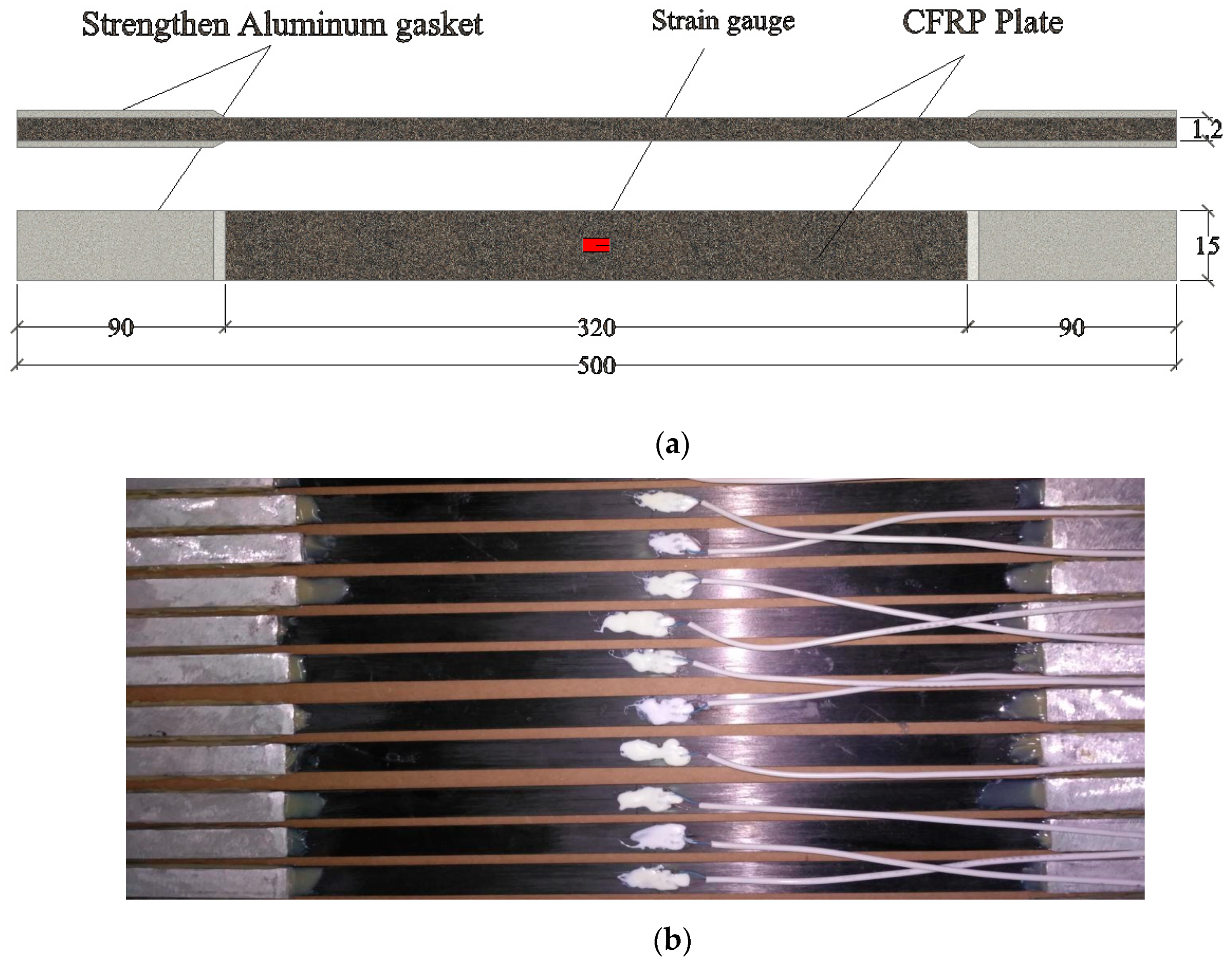

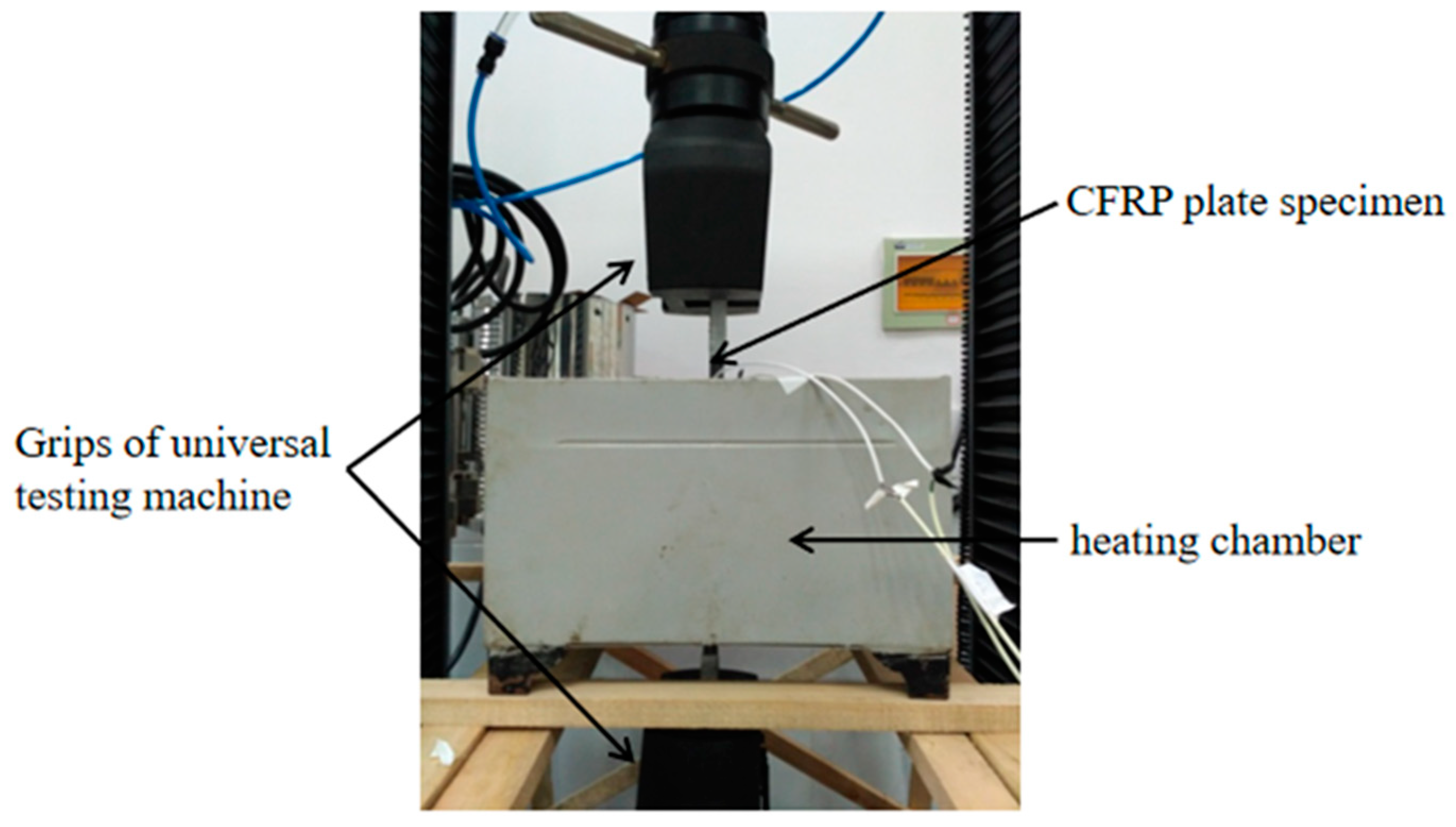
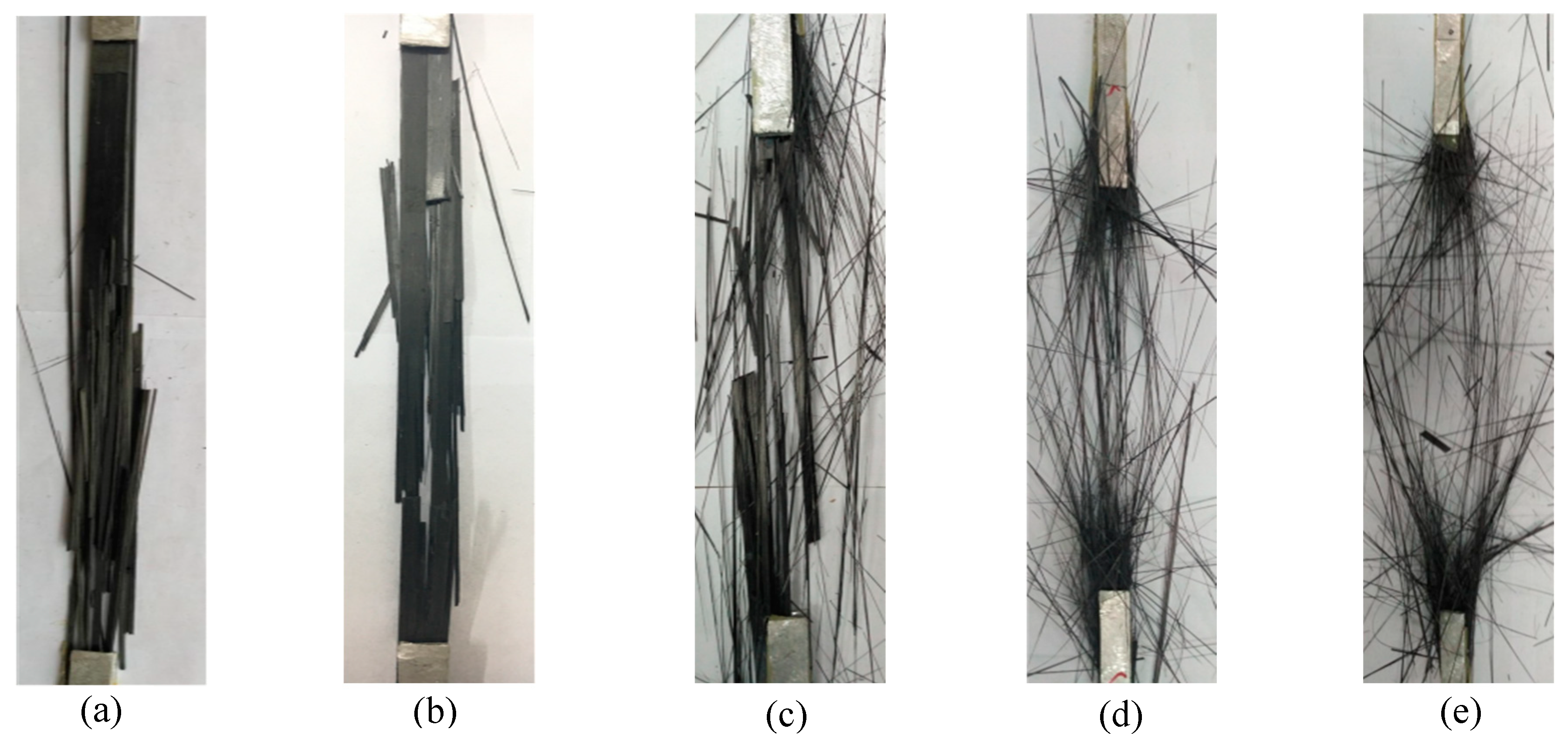

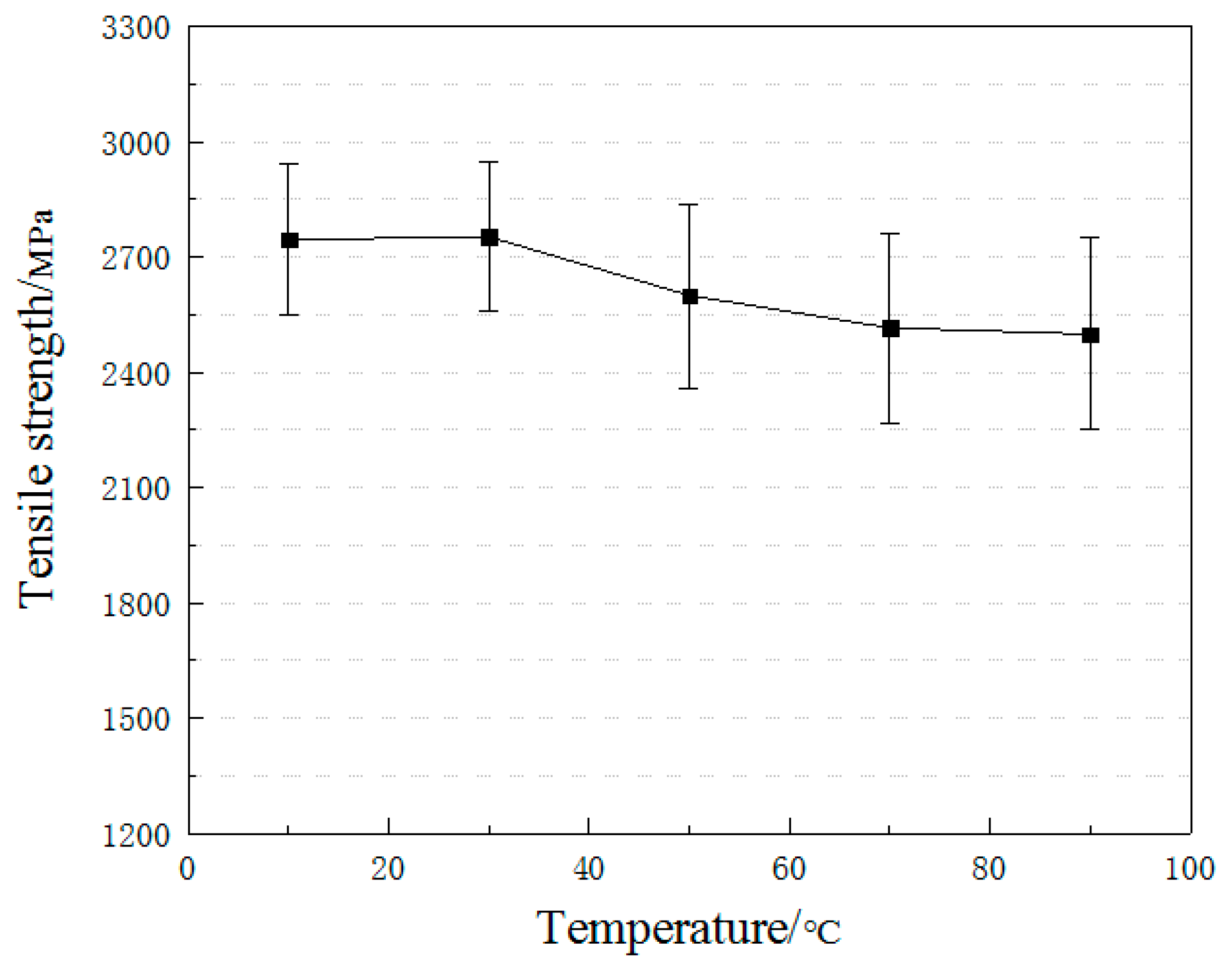

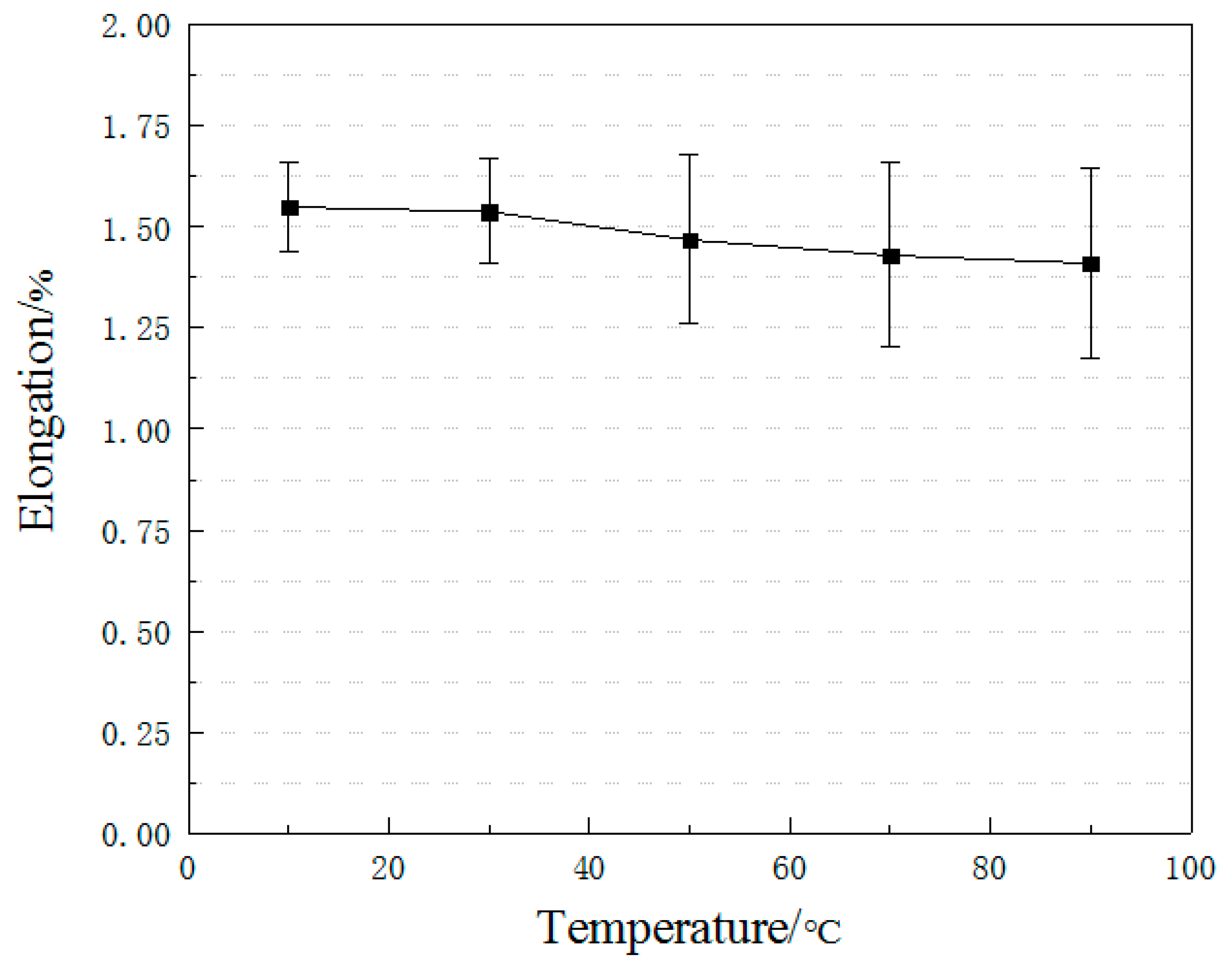
| Samples | T/°C | Number | Ultimate Load/kN | Ultimate Strength/MPa | Elastic Modulus/GPa | Elongation/% | |||
|---|---|---|---|---|---|---|---|---|---|
| Mean | Standard Deviation | Mean | Standard Deviation | Mean | Standard Deviation | ||||
| C-T10 | 10 | 6 | 49.78 | 2748 | 196.52 | 177.24 | 3.71 | 1.55 | 0.118 |
| C-T30 | 30 | 6 | 49.57 | 2754 | 196.02 | 177.45 | 3.84 | 1.54 | 0.121 |
| C-T50 | 50 | 6 | 46.76 | 2597 | 239.5 | 176.36 | 5.04 | 1.47 | 0.178 |
| C-T70 | 70 | 6 | 45.28 | 2515 | 244.02 | 176.03 | 5.35 | 1.43 | 0.208 |
| C-T90 | 90 | 6 | 45.02 | 2501 | 249.51 | 175.65 | 5.57 | 1.41 | 0.203 |
| Performance Indicators | Ultimate Strength (MPa) | Elastic Modulus (GPa) | Elongation (%) |
|---|---|---|---|
| CFRP plates | 2400 | 160 | 1.4 |
| Sources | Degree of Freedom | Sum of Squares | Mean Squares | F-Value | Critical F-Value | |
|---|---|---|---|---|---|---|
| Tensile strength | Feed | 4 | 360060 | 90015 | 2.4 | 2.18 |
| Residuals | 25 | 921307 | 36852 | — | — | |
| Elastic modulus | Feed | 4 | 14.415 | 3.604 | 6.29 | 2.18 |
| Residuals | 25 | 567.125 | 22.685 | — | — |
© 2019 by the authors. Licensee MDPI, Basel, Switzerland. This article is an open access article distributed under the terms and conditions of the Creative Commons Attribution (CC BY) license (http://creativecommons.org/licenses/by/4.0/).
Share and Cite
Yang, Y.; Jiang, Y.; Liang, H.; Yin, X.; Huang, Y. Study on Tensile Properties of CFRP Plates under Elevated Temperature Exposure. Materials 2019, 12, 1995. https://doi.org/10.3390/ma12121995
Yang Y, Jiang Y, Liang H, Yin X, Huang Y. Study on Tensile Properties of CFRP Plates under Elevated Temperature Exposure. Materials. 2019; 12(12):1995. https://doi.org/10.3390/ma12121995
Chicago/Turabian StyleYang, Yongxin, Yanju Jiang, Hongjun Liang, Xiaosan Yin, and Yue Huang. 2019. "Study on Tensile Properties of CFRP Plates under Elevated Temperature Exposure" Materials 12, no. 12: 1995. https://doi.org/10.3390/ma12121995
APA StyleYang, Y., Jiang, Y., Liang, H., Yin, X., & Huang, Y. (2019). Study on Tensile Properties of CFRP Plates under Elevated Temperature Exposure. Materials, 12(12), 1995. https://doi.org/10.3390/ma12121995





